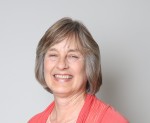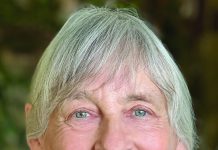Reunion Proves a Strange Trip

The projection screen was down. There was equipment and fussing around with it as author Nick Schou prepared to talk about his 2010 book, “Orange Sunshine, the Brotherhood of Eternal Love and Its Quest to Spread Peace, Love, and Acid to the World.”
The noontime event last week was in conjunction with the art exhibit at Coastline Community College, “Orange Sunshine and the Mystic Artists, 1967-1970.” I expected this to be a typical presentation by a writer: reading from parts of the book, showing a power point of some of the photographs, summarizing some of the key points and then offering to sell and sign books. But this wasn’t typical.
No pictures on the screen, no cartons of books. Most of the people in the audience had already read the book and some had copies in their hands. After the introduction by Bolton Colburn, curator of the exhibit, Schou was alone on a stool at the front of the spare college classroom. He summarized the story.
Several years before LSD became illegal in1966, Brotherhood founder John Griggs and cohorts experimented with the drug in ritualized ways, believing that it was a key to enlightenment. Using Timothy Leary’s text for guidance, partakers reported religious, out of body experiences that changed their lives forever. In 1966 they legally formed the Brotherhood of Eternal Love as a church. The group moved from Modjeska Canyon to Laguna Canyon in 1967 and created Mystic Arts World, a center of psychedelic art and culture on South Coast Highway. It is the art work that was displayed there that is featured in the Coastline College exhibit.
The other side of this controversial group involved a network of suppliers, smugglers and promoters of marijuana, LSD and hashish. A 1972 Orange County wanted poster gives the law-enforcement view: “This (Brotherhood of Eternal Love) is a pseudo-religious organization responsible for the importation and sale of large quantities of hashish and manufacture and distribution of LSD on a world-wide level.”
Schou explained how difficult it had been to gather the information for the book. Who really were members of the Brotherhood? Where were they? Who were the reliable sources? Then the all-important question, “Were they willing to talk?” In the five years since the book was published more sources and information have been revealed. “Certainly I could have done a more complete book had some of this been available,” he said in taking responsibility for its contents.
“Are there any questions?” Schou opened up the discussion.
It seemed many of the people in the audience had been involved in the Brotherhood in some way. It’s not often that a subject of a book gets to confront the author, but that is what happened.
“How can you stop distribution of the book?” a woman in the front row demanded. “It has ruined my life. It’s all lies!”
“Will you do a follow-up book making corrections?” another asked.
Schou stood by his book given the limitations of information he had already explained. But he would do a second book, if the publisher were interested.
His book describes the three-day 1970 Christmas Happening in Laguna Canyon at which an unmarked plane dropped thousands of cards to the camping concert-goers. Each card contained a tab of Orange Sunshine LSD, compliments of the Brotherhood. The audience didn’t agree on that story either.
“I was there at the Christmas Happening, and there was no plane or helicopter dropping cards with acid. I was there handing them out. I know.”
“The Brotherhood was gone by then anyway,” another chimed in. “It wasn’t the Brotherhood behind that Christmas thing.”
“I printed the cards,” said another who seemed to be speaking as a Brotherhood member.
This turned out to be like a class reunion of people sharing their remembrances, but they often didn’t agree with the book or with each other. I respected more and more the challenge Schou faced. Still, each person sees events differently, perhaps was part of only a few pieces of the puzzle and wants their part in the story to be told as they saw it.
“We just wanted to do good things for people. Selling the hash and drugs was a way to make money to help people. We didn’t make it for ourselves, buying fancy cars or anything like that,” I was told as I wandered through the crowd at the end of the event.
This story could not be told on a power point, there are nuances every way you turn, and the event left us wondering not only what the real story was, but what it all meant.
I pondered. The Brotherhood was just one of the more extreme and colorful examples of the love and peace movement that arose nationwide. Spontaneity and idealism were hallmarks and creative expression was made possible by freedoms we don’t have today—to travel inexpensively, to attend college at reasonable cost, to easily find places to live, to have the time to search for enlightenment… There were dangers and uncertainty lurking around the paths we took, but I feel blessed to be a part of that generation.
Landscape architect Ann Christoph served on the Laguna Beach City Council.





[…] article about Nick Schou’s talk is the best piece of journalism on the subject I’ve seen, and […]
Thought this was an excellent article and responded, which resulted in my response being posted here: http://www.lagunabeachindy.com/where-are-the-truthtellers/ Thank you!
Historic !!!!!